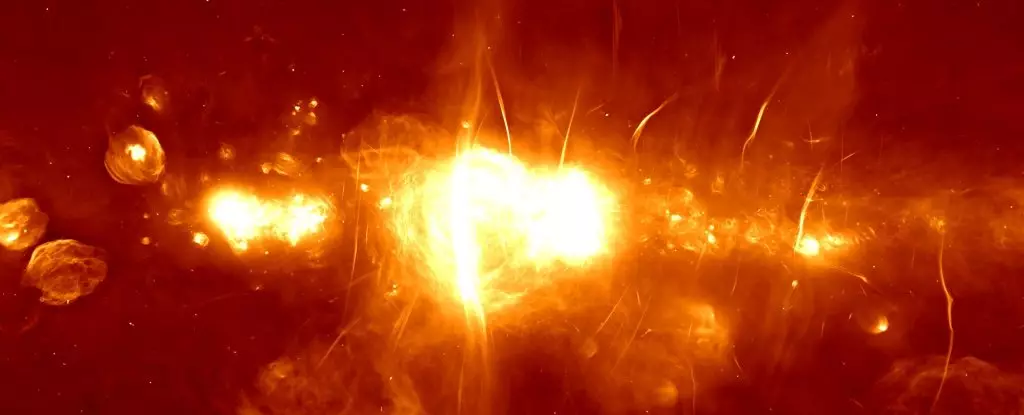Recent explorations within the enigmatic Central Molecular Zone (CMZ) of the Milky Way reveal an array of unprecedented gaseous filaments that behave more like cosmic tornadoes than typical Galactic structures. A team led by astronomer Kai Yang from Shanghai Jiao Tong University has unveiled these slender, tumultuous formations which defy existing conventions about how material disperses within the vicinity of our supermassive black hole.
This discovery not only sheds light on the complex dance of cosmic phenomena but pushes the boundaries of our understanding of star formation and molecular gas behaviors. Historically, astronomers have identified filaments in various forms around the galactic center, yet these “slim filaments,” as they have been dubbed, present a new paradigm. Their existence challenges established notions of gas dynamics and invites fresh questions about the physics governing our universe.
The Anatomy of the Central Molecular Zone
The CMZ itself is a remarkable environment; this densely populated space measures up to 2,000 light-years across and contains roughly 80 percent of the Milky Way’s dense gas. The sheer volume of matter results in a chaotic atmosphere where clouds of gas move at impressive velocities, creating a consistent array of shocks and turbulence. It is a cosmic ballet of births and deaths, a realm where clouds materialize, collapse, and reform repeatedly, yet the forces that drive this perpetual motion remain elusive.
Studying the CMZ is fraught with challenges due to its density. Traditional observational methods can struggle against the opaqueness of dust and gas that saturate the region. To penetrate this veil, Yang and his colleagues employed the Atacama Large Millimeter/submillimeter Array (ALMA) in Chile, specifically targeting silicon monoxide, a molecule known for indicating shockwaves—a focal point in understanding the turbulence within the filaments.
Filaments that Act Like Tornadoes
What the team ultimately found was remarkable. ALMA revealed intricate structures made of silicon monoxide that formed long, narrow filaments unlike any previously documented. In stark contrast to existing models of filaments within the CMZ, these slim filaments are characterized by their velocity distributions, which suggest a dominance of turbulent pressure—a hallmark of dynamic instability similar to that of tornadoes on Earth.
Their analysis shows that these filaments are not merely passive constructs but active participants in the circulation of matter within the CMZ. According to Xing Lu, another key member of the research team, these slim filaments are reminiscent of space tornadoes: “They are violent streams of gas,” he states, emphasizing their rapid dissipation and the role they play in efficiently redistributing materials across the galactic landscape. This new information could redefine our understanding of how gas moves and transforms within the cosmic environment.
The Chemistry of Cosmic Tornadoes
In addition to silicon monoxide, the slim filaments also house complex organic molecules such as formaldehyde, methanol, and acetonitrile. These compounds are crucial for understanding the chemical processes that occur in the cosmos. The interactions between these materials in the slim filaments suggest a dynamic laboratory of sorts, where molecular reactions contribute to the chemical richness of the galactic center.
There is, however, a significant gap in knowledge: the precise mechanisms driving the formation of these filaments remain largely speculative. The researchers theorize that the intense shocks generated by the tumultuous environment in the CMZ are fundamental to generating these tornado-like structures. As shocks collide and interact, they likely crank up the temperature within the clouds, converting complex molecules into their gaseous forms before releasing them into the interstellar ether. As these gases cool, they revert to dust, playing an instrumental role in the recycling processes that characterize the CMZ.
Redefining Cosmic Recycling
If the researchers’ hypothesis holds true, the implications are far-reaching. The distribution and prevalence of slim filaments could elucidate a considerable portion of the material recycling occurring in the CMZ. They suggest that these structures may signify a unique category of filaments that differ from those observed in neighboring molecular clouds. Such insights push the envelope of current astrophysical models and elevate the significance of investigative work in the galactic core.
Ultimately, the identification of such tendrils of gas fosters a deeper appreciation for the dynamic processes that orchestrate the evolution of our galaxy. By revealing the turbulent and complex nature of the CMZ, astronomers are not merely making a discovery; they are weaving a richer tapestry of the cosmos in which we reside, allowing us a clearer glimpse into the chaotic beauty of the universe at play.


Leave a Reply